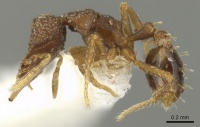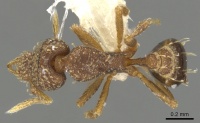Strumigenys aethegenys
| Strumigenys aethegenys | |
|---|---|

| |
| Scientific classification | |
| Kingdom: | Animalia |
| Phylum: | Arthropoda |
| Class: | Insecta |
| Order: | Hymenoptera |
| Family: | Formicidae |
| Subfamily: | Myrmicinae |
| Tribe: | Attini |
| Genus: | Strumigenys |
| Species: | S. aethegenys |
| Binomial name | |
| Strumigenys aethegenys (Bolton, 2000) | |
A forest species that has been sampled from leaf-litter.
Identification
Bolton (2000) - A member of the crassicornis complex in the Strumigenys gundlachi group. The very distinct carina that arches across the posterior vertex renders aethegenys immediately recognisable.
Longino (Ants of Costa Rica) - Vertex with prominent transverse ridge, a unique feature of this species; mandibles in full-face view linear, elongate and narrow; ventral surface of petiole without spongiform tissue; leading edge of scape with freely projecting hairs; inner margin of mandible with a clearly defined submedian tooth near the midlength; labral lobes long, trigger hairs at apices of lobes short; preapical denticles gradually decreasing in size.
Keys including this Species
Distribution
Latitudinal Distribution Pattern
Latitudinal Range: 10.3346146° to 8.407045°.
| North Temperate |
North Subtropical |
Tropical | South Subtropical |
South Temperate |
- Source: AntMaps
Distribution based on Regional Taxon Lists
Neotropical Region: Costa Rica (type locality), Panama.
Distribution based on AntMaps
Distribution based on AntWeb specimens
Check data from AntWeb
Countries Occupied
| Number of countries occupied by this species based on AntWiki Regional Taxon Lists. In general, fewer countries occupied indicates a narrower range, while more countries indicates a more widespread species. |

|
Estimated Abundance
| Relative abundance based on number of AntMaps records per species (this species within the purple bar). Fewer records (to the left) indicates a less abundant/encountered species while more records (to the right) indicates more abundant/encountered species. |

|
Biology
Castes
Nomenclature
The following information is derived from Barry Bolton's Online Catalogue of the Ants of the World.
- aethegenys. Pyramica aethegenys Bolton, 2000: 179 (w.) COSTA RICA. Combination in Strumigenys: Baroni Urbani & De Andrade, 2007: 115
Description
Worker
HOLOTYPE. TL 1.8, HL 0.50, HW 0.36, CI 72, ML 0.16, MI 32, SL 0.22, SI 61, PW 0.24, AL 0.49. Characters of crassicornis complex. Masticatory margin of mandible with 4 dentic1es between apicodorsal and submedian tooth; with 2 denticles proximal of submedian tooth. Scape very narrow basally, suddenly expanded and almost lobate at subbasal angle (similar to development seen in crassicomis but not as extensive), the scape distinctly broadest at this point, tapering to apex. Eye with 5 ommatidia in total. Vertex in full-face view with a coarse and very conspicuous arched carina traversing its width; the carina also very distinct in anterior or posterodorsal view. In profile the carina forms the apex of a strongly raised sub triangular peak in the dorsal outline and the head at this point is very deep (maximum depth of head capsule 0.56 X HL); the surface falls away steeply both in front of and behind the peak. Entire dorsum of head with short spatulate ground-pilosity. Apicoscrobal hair absent. Dorsum of head near the occipital margin with a pair of short remiform standing hairs that are curved anteriorly. Pronotal humeral hair small and spoon-shaped; mesonotum without standing hairs. Ventral spongiform lobe of postpetiole large and conspicuous.
Type Material
Holotype worker, Costa Rica: Prov. Puntarenas, Osa, Rancho Quemado, 8°42'N, 83°33'W, 2-300 m., 15.xii.1990, no. 2760-5, wet forest, ex sifted litter (J. Longino) (The Natural History Museum).
Paratype. 1 worker, Costa Rica: Provo Limon, 3 km. SSE Cahuita, 9°43'N, 82°50'W, 70 m., 24.xii.1983, sifted litter (leaf mold, rotten wood), rainforest, #6530-12 (P.S. Ward) (University of California, Davis).
References
- Baroni Urbani, C. & De Andrade, M.L. 2007. The ant tribe Dacetini: limits and constituent genera, with descriptions of new species. Annali del Museo Civico di Storia Naturale “G. Doria” 99:1-191.
- Bolton, B. 2000. The ant tribe Dacetini. Memoirs of the American Entomological Institute. 65:1-1028. (page 179, worker described)
- [[Media:Silva, T.S.R.D., Chaul, J.C.M. et al. 2022. Lectotype designation and redescription of four commonly collected Neotropical species of Strumigenys (10.5852@ejt.2022.798.1673).pdf|Silva, T.S.R.D., Chaul, J.C.M., Feitosa, R.M. 2022. Lectotype designation and redescription of four commonly collected Neotropical species of Strumigenys (Hymenoptera: Formicidae). European Journal of Taxonomy, 798(1), 103–126 (Template:Doi.org).]]
References based on Global Ant Biodiversity Informatics
- Longino J. T. L., and M. G. Branstetter. 2018. The truncated bell: an enigmatic but pervasive elevational diversity pattern in Middle American ants. Ecography 41: 1-12.
- Longino J. T., and R. K. Colwell. 2011. Density compensation, species composition, and richness of ants on a neotropical elevational gradient. Ecosphere 2(3): 16pp.
- Longino J. et al. ADMAC project. Accessed on March 24th 2017 at https://sites.google.com/site/admacsite/

